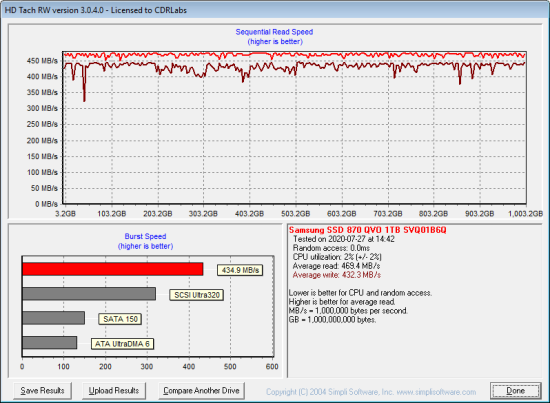TRIM Performance:
While SSDs offer many benefits, there are some downsides to using flash memory. One of the biggest issues people run into is performance degradation. Over time, an SSD will run out of fresh blocks and will have to write over data the file system has marked as deleted. This procedure is very complicated and can slow an SSD's write speeds considerably.
To fix this problem, most manufacturers have added TRIM support to their SSDs. The TRIM command allows an operating system, such as Windows 7, to tell an SSD which data blocks are no longer in use. Using this information, the drive pro-actively erases these blocks and adds them to the free block pool.

To test the 870 QVO's TRIM function, I first put the drive in a "dirty" state. I used Iometer to fill the entire drive and then ran a random write test for 30 minutes. Looking at the screenshot below, you can see that the 870 QVO's average read and write speeds dropped to 344.2 MB/s and 14.0 MB/s, respectively.

Samsung 870 QVO - Dirty
To see how well the 870 QVO could recover, I let the computer sit for about 30 minutes and then reran the test. The drive wasn't able to reach the factory fresh performance shown in our earlier tests. However, its average write speed jumped up to 338.9 MB/s.

Samsung 870 QVO - After Trim
Lastly, I used Parted Magic to perform a secure erase on the 870 QVO. With the drive wiped clean, it had average read and write speeds of 469.4 MB/s and 432.3 MB/s, respectively.

Samsung 870 QVO - Secure Erase
Final Thoughts:
In the past, consumers had to choose between the superior performance of SSDs and the high capacity of hard drives. With Samsung's new 870 QVO SSD, they can now get the best of both worlds. Designed and built entirely in-house, this new SATA SSD is powered by Samsung's own MKX "Metis" controller and is available with up to 8TB of their latest 4-bit MLC V-NAND flash. Combine this with the company's Intelligent TurboWrite technology and you have a drive that delivers speed, storage capacity and reliability at a reasonable price. In our tests, the 1TB version of the 870 QVO was able to read at speeds as high as 561 MB/s and write at speeds in excess of 531 MB/s. It also had no problems holding its own in our random write tests, producing more than 87,000 IOPS at low queue depths.
Of course, speed and capacity aren't the only things the 870 QVO has to offer. Along with support for Samsung's Intelligent TurboWrite technology, the drive features AES 256-bit full disk encryption and is compliant with both the TCG Opal 2.0 and IEEE 1667 specifications. The 870 QVO also supports the Device Sleep (DEVSLP) standard which extends the battery life of a device by reducing the drive's power consumption when it's not in use. To top it all off, the drive works with Samsung's Magician software and is covered by a 3 year warranty with an endurance rating of up to 2,880 terabytes written (TBW) for the 8TB model.
The 870 QVO is available now in 1TB, 2TB and 4TB capacities. Prices on Amazon.com start at $130 for the 1TB version and go up to $500 for the 4TB drive. The 8TB version is expected to ship in late August for about $900.

Highs:
- Equipped with 4-bit MLC V-NAND technology
- Available in 1TB, 2TB, 4TB and 8TB capacities
- Good sequential read and write speeds under most conditions
- Good random read and write performance
- Features Intelligent TurboWrite technology
- Large DRAM cache
- Supports TRIM and garbage collection
- AES 256-bit full disk encryption
- TCG Opal 2.0 and IEEE 1667 compliant
- DEVSLP power mode
- Includes SSD Magician software and Data Migration Tool
- Reasonably priced
- 3 year warranty
Lows:
- Write speed drops considerably when SLC cache is full
- Lower endurance than many TLC NAND-based SSDs

